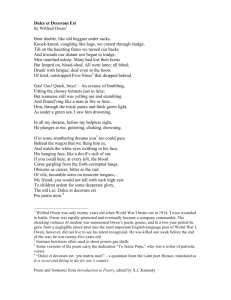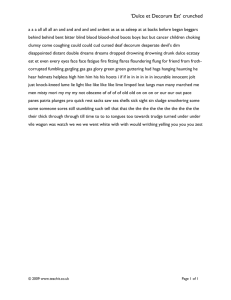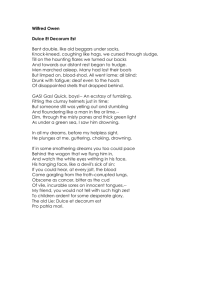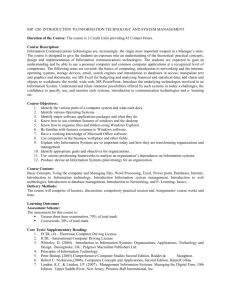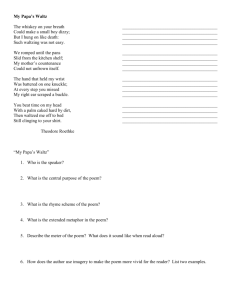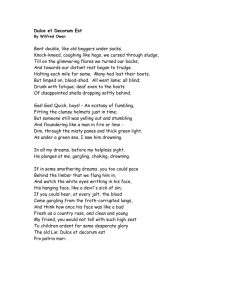Student: Selecting evidence from multiple sources
advertisement
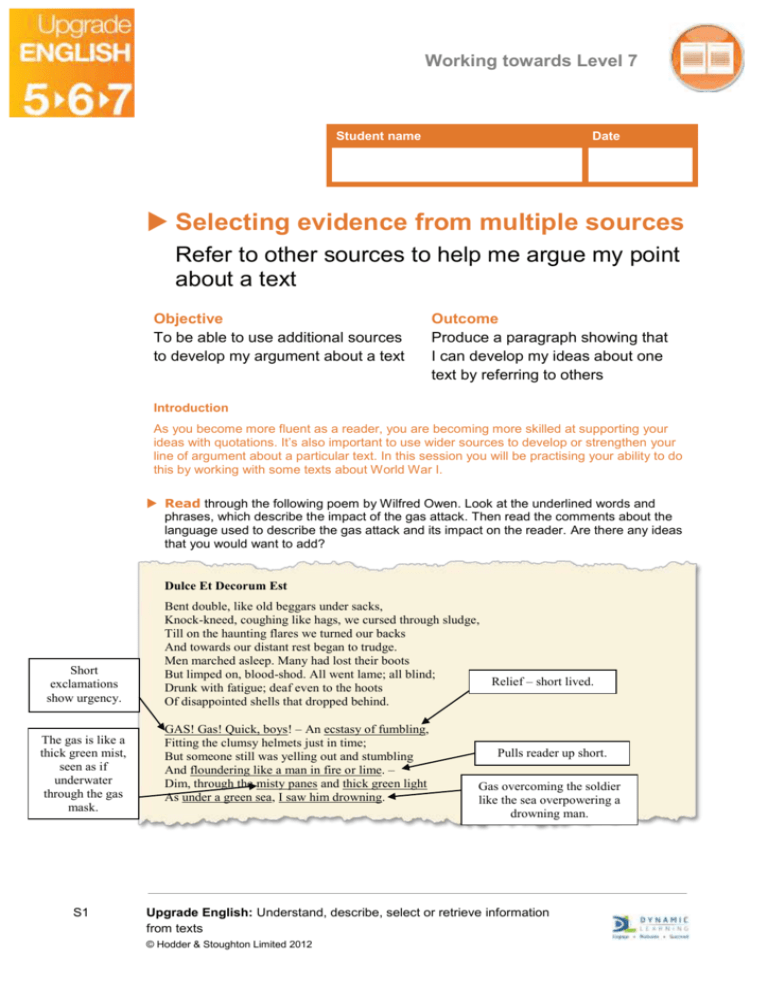
Working towards Level 7 Student name Date Selecting evidence from multiple sources Refer to other sources to help me argue my point about a text Objective To be able to use additional sources to develop my argument about a text Outcome Produce a paragraph showing that I can develop my ideas about one text by referring to others Introduction As you become more fluent as a reader, you are becoming more skilled at supporting your ideas with quotations. It’s also important to use wider sources to develop or strengthen your line of argument about a particular text. In this session you will be practising your ability to do this by working with some texts about World War I. Read through the following poem by Wilfred Owen. Look at the underlined words and phrases, which describe the impact of the gas attack. Then read the comments about the language used to describe the gas attack and its impact on the reader. Are there any ideas that you would want to add? Dulce Et Decorum Est Short exclamations show urgency. The gas is like a thick green mist, seen as if underwater through the gas mask. S1 Bent double, like old beggars under sacks, Knock-kneed, coughing like hags, we cursed through sludge, Till on the haunting flares we turned our backs And towards our distant rest began to trudge. Men marched asleep. Many had lost their boots But limped on, blood-shod. All went lame; all blind; Relief – short lived. Drunk with fatigue; deaf even to the hoots Of disappointed shells that dropped behind. GAS! Gas! Quick, boys! – An ecstasy of fumbling, Fitting the clumsy helmets just in time; But someone still was yelling out and stumbling And floundering like a man in fire or lime. – Dim, through the misty panes and thick green light As under a green sea, I saw him drowning. Pulls reader up short. Gas overcoming the soldier like the sea overpowering a drowning man. Upgrade English: Understand, describe, select or retrieve information from texts © Hodder & Stoughton Limited 2012 Working towards Level 7 Nightmare imagery – narrator can’t help. Description of the sound of the soldier breathing – blood oozing from his lungs conveys sense of horror. In all my dreams, before my helpless sight, He plunges at me, guttering, choking, drowning. If in some smothering dreams you too could pace Behind the wagon that we flung him in, And watch the white eyes writhing in his face, His hanging face, like a devil’s sick of sin; If you could hear, at every jolt, the blood Come gargling from the froth-corrupted lungs, Obscene as cancer, bitter as the cud Of vile, incurable sores on innocent tongues, – My friend, you would not tell with such high zest To children ardent for some desperate glory, The old Lie: Dulce et decorum est Pro patria mori. Powerful verbs emphasise extreme physical impact of the gas. Soldier cannot breathe. Think about what we learn about the writer’s attitude to the subject matter. Look at instances where the writer: feels the horror of the gas attack describes the impact on one person to really drive home the horror uses imagery to intensify the horror and shows his stance – that war should not be seen as glorious – and his determination to reveal the harsh reality of war. Now read this extract from ‘Gas Attack’ from Over the Top by Arthur Empey. Warnings had been passed down the trench to keep a sharp lookout for gas. We had a new man at the periscope, on this afternoon in question; I was sitting on the fire step, cleaning my rifle, when he called out to me: ‘There’s a sort of greenish, yellow cloud rolling along the ground out in front, it’s coming –’ But I waited for no more; grabbing my bayonet, which was detached from the rifle, I gave the alarm by banging an empty shell case, which was hanging near the periscope. At the same instant, gongs started ringing down the trench, the signal for Tommy to don his respirator, or smoke helmet, as we call it. Gas travels quickly, so you must not lose any time; you generally have about 18 or 20 seconds in which to adjust your gas helmet … For a minute, pandemonium reigned in our trench, – Tommies adjusting their helmets, bombers running here and there, and men turning out of the dugouts with fixed bayonets, to man the fire step … S2 Upgrade English: Understand, describe, select or retrieve information from texts © Hodder & Stoughton Limited 2012 Working towards Level 7 Next you are going to look at points (with a quotation) that you could make about Owen’s poem. You will be asked first to add evidence/evaluation and then to cite evidence from an additional source to add further support to your argument. For example, the extract you have just read could be used to provide additional evidence like this: The urgency of responding to the attack is shown in the change of rhythm in the poem. The two exclamations of ‘GAS! Gas!’ followed by ‘Quick, boys!’ show the urgency of the situation. The speaker here only has time to shout the briefest of warnings. The panic in the reader is highlighted by the description of the soldiers ‘Fitting the clumsy helmets just in time’. The word ‘clumsy’ highlights the awkwardness of the manoeuvre and the need to act quickly. An eyewitness account of a gas attack reinforces the way in which Owen creates this sense of panic. Arthur Empey in 1917 described how ‘… you must not lose any time; you generally have about 18 or 20 seconds in which to adjust your gas helmet’. Begin by watching a short video about poison gas in World War I. Now finish the PEE sequence for the following point and quotation about ‘Dulce et Decorum Est’. After you have added an explanation/evaluation, try to reinforce your argument using either the Empey text or the video as an additional source. The gas overcomes the soldier like the sea overpowering a drowning man. The speaker in the poem describes how the gas envelops the soldier ‘As under a green sea, I saw him drowning.’ ____________________________________________________________________________ ____________________________________________________________________________ ____________________________________________________________________________ ____________________________________________________________________________ ____________________________________________________________________________ ____________________________________________________________________________ Now read the following extract from Birdsong by Sebastian Faulks. This author creates another very vivid picture of the impact of a gas attack – but in prose rather than in a poem. You could watch the video about gas attacks again to remind you of the situations soldiers in World War I faced. S3 Upgrade English: Understand, describe, select or retrieve information from texts © Hodder & Stoughton Limited 2012 Working towards Level 7 … One morning a boy of nineteen appeared at the end of the ward. His eyes were covered with pieces of brown paper ... He was trying to scream. His mouth pulled open and the sinews of his neck were stretched but some throat condition appeared to prevent any sound from issuing. The MO [Medical Officer] peeled the brown paper from the boy’s face. The skin of his cheeks and forehead was marked with bluish violet patches. Both of his eyes were oozing, as though with acute conjunctivitis. They rinsed them in fluid from a douche cup into which the nurse had tipped some prepared solution. His body stiffened silently … They walked down the ward and when they came closer, Stephen could see the pattern of burns on his body. The soft skin on the armpits and inner thighs was covered in huge, raw blisters. He was breathing in short, fast gasps. They persuaded him onto the bed, though he arched his body away from the contact of the sheet. Eventually the doctor lost patience and forced him down with hands on his chest. The boy’s mouth opened in silent protest, bringing forth a yellow froth from his lips. When the doctor came to inspect them, Stephen asked him what had happened to the boy. He had apparently been caught by a gas attack some way behind the front line. Blinded by the chlorine, he had stumbled into a house that was burning after being hit by a shell. ‘Stupid boy didn’t get his mask on in time,’ said the MO. ‘They have enough drills.’ ‘Will he die?’ ‘Probably. He’s got liver damage from the gas. Some post mortem changes in his body already.’ ... Throughout the night they contrived to keep the boy alive. The next day he was quiet, and in the evening they tried to lever him into the body cradle to get him back in the bath. His limbs dangled over the side of the canvas. He lay motionless, trailing his raw skin. His infected lungs began to burble and froth with yellow fluid that choked his words of protest as they lowered him into the stone bath outside … Read the following point and quotation about the poem. Owen creates a vivid picture of the soldier dying from the effects of the gas. He describes the blood ‘gargling from the froth-corrupted lungs’. Now, add the explanation/evaluation part of the PEE sequence. You should refer to one of the additional sources (the video or either text) to support your ideas about the effectiveness of the imagery used by Owen. ____________________________________________________________________________ ____________________________________________________________________________ ____________________________________________________________________________ ____________________________________________________________________________ ____________________________________________________________________________ S4 Upgrade English: Understand, describe, select or retrieve information from texts © Hodder & Stoughton Limited 2012 Working towards Level 7 ____________________________________________________________________________ ____________________________________________________________________________ S5 Upgrade English: Understand, describe, select or retrieve information from texts © Hodder & Stoughton Limited 2012
